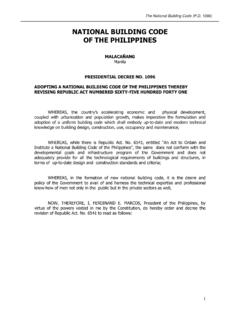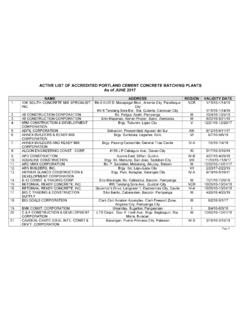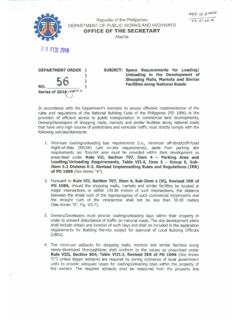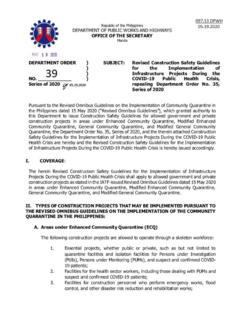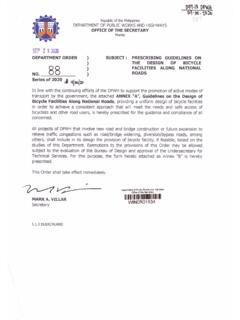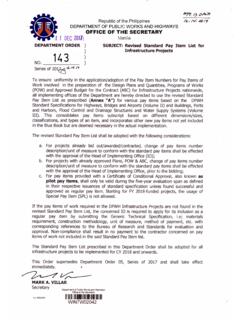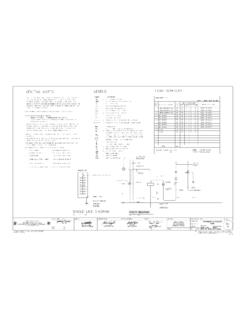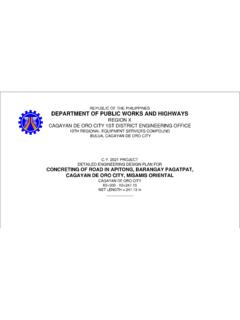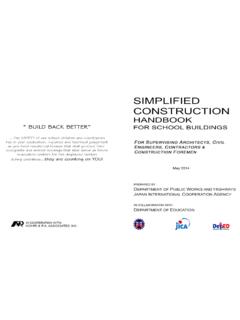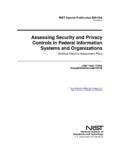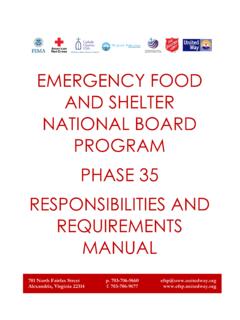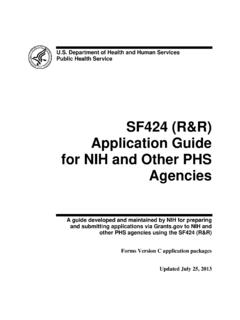Transcription of PHILIPPINE NATIONAL ROAD NETWORK I. Road Classification
1 1 PHILIPPINE NATIONALROAD ClassificationA number of laws have been passed regarding the Classification of roads in the country. The firstcomprehensive reference to a Road Classification System isfound in Republic Act No. 917, knownas the PHILIPPINE Highway Act, enacted in 1953 and Executive Order ( ) No. 113, Series of1955. 113 also laid downthe criteria for Classification of NATIONAL roadsand forconversion from local roads to nationalroads. Thisdirectiveclassified the roads intoNationalPrimary and NATIONAL Secondary classes as well as delineatedthe so-called " NATIONAL aid"provincial and city roads of sufficient 1987, by virtue 124, Series of 1987,Department of Public Works and Highways(DPWH), through the Secretary, was given thepower to classify roads and highways and also toprovide and authorize the conversion of roads and highways from one category to April 2002, a TechnicalWorking Group(TWG)was established in connection with the NewPlanning Process under NRIMP-1, where the main recommendation was to transfer over 10,000km.
2 Of NATIONAL roads to theLocal Government Units (LGU s)but this did not June 2009,amemorandum was approved by then Secretary Hermogenes E. Ebdane, to the Department s criteria/guidelines on road functional Classification . NATIONAL roadswere classified in relation to its functionality to the local road networkintoNationalPrimaryArterial Road(which is further categorized into: North-South Backbone, East-West Lateral, OtherRoads of Strategic Importance) andNationalSecondary North-South Backbone was the main trunk line from northernmost Luzon down to SouthernMindanao interconnecting major islands while the East-West Laterals were the roads traversingthe backbone and across the islands.
3 Other Roads of Strategic Importance were direct access toimportant centers and areas vital for regional development and emergencies. NATIONAL Secondaryroads were other roads which complemented NATIONAL arterial roads that provided access to othermajorpopulation and production April 14, 2014, a memorandum was issued by Secretary Rogelio L. Singson regarding thenewRoad Classification System as well as the Route numbering to all primary roads that has beenextended to secondary roads at present. This Road Classification and Route numbering Systemwas then implemented and incorporated in the Road and Bridge Information Application (RBIA)in compliance to the said memorandum.
4 Thesucceedingtableprovidesthe criteria for each ofthese classes of ACurrentClassification System(Per 133, s. 2018) NATIONAL PrimaryRoads A contiguous lengthof significant road sections extending linearlywithout any breaks or forks that connect major cities (at least around100,000 population) comprising the main trunk line or the backboneof the NATIONAL road Directly connectcities to NATIONAL Primary Roads, except inmetropolitan areas Directly connectmajor ports and ferry terminals(as defined by DOTr)to NATIONAL Primary Roads Directly connect major airports(as defined by DOTr)to NationalPrimary Roads Directly connect tourist service centers(as defined byDOT)
5 ToNationalPrimary Roads or other NATIONAL Secondary Roads Directly connect cities (not included in the category of major cities) Directly connect provincial capitals within the same region Directly connect major NATIONAL Government Infrastructure to NationalPrimary Roads or other NATIONAL Secondary RoadsApplicable onlyfor Primary andSecondaryRoads Bypass/Diversion Roads Roads that divert through traffic away fromthe city/municipality business centers(with affirmative feasibilitystudy) Roads that would connect or fill the gap between adjoining nationalroads (protruding) to form a continuous NATIONAL road Other existing roads under DPWH which perform a local functionProvincialRoads Connect cities and municipalities without traversing NATIONAL Roads Connect to NATIONAL Roads to barangays through rural areas Connect to major provincial government infrastructureMunicipaland City Roads Roads withinaPoblacion Roads that connect to Provincial and NATIONAL Roads Roads that provide inter-barangay connections to major Municipal andCity Infrastructure without traversing Provincial RoadsBarangay Roads Other Public Roads (officially turned over)
6 Within the barangay and notcovered in the above definitionsExpressways Highways with limited access, normally with interchanges; may includefacilities for levying tolls for passage in an open or closed have been made to the new Classification with the inclusion of the NationalTertiary class, instead of transferring 10,000 km. of NATIONAL Roads to the Local Government(city and municipality).No route numbers were assigned toTertiary Roads as they function aslocal numbering System (RNS)Along with a new Functional Classification , a Route NumberingSystem was created which canbe easily understood by road users.
7 Routenumbering is essential to road usersin planningtheiritinerary. Road users will also expect that all roads of a certain Classification , and of a certainnumbering scheme, will have similar performance standards. A well-numbered, well-signed andwell-publicized route system is also useful for road agencies and other government bodies tochannel traffic into preferred routes or details of the road Classification and numbering can be viewedthrough this web link: ,which shall also be the officialsource of this been devised for Expressways, Primary Roads and Secondary Roads at present. Itmay be expanded to the Tertiary class at a later BRoute numbering SystemClassificationNumberingNational PrimaryNos.
8 N1 to N49 for the "main" routes or corridors, connecting 3 or more citiesNos. N50 to N99 for other primary routes connectingtwo citiesNational SecondaryNos. 100 to 999 ExpresswaysE1, E2, E3, areprefixed by the letter E for Expressway, in order to differentiate these roadsin road user s mind from other types of road. The letter E implies a different design andstandard of road, and indicates to the public that a toll may be required. Expressways arenumbered continuously. A new number is not given simply because a different concessionaire isin Roads are numbered differently according to whether they form main corridors, orwhether they only connect two N1 toN49 are used for main routes orcorridors like those connecting three or more cities.
9 While, numbers N50 o N99 are for otherprimary routes connecting two cities. This is purely for convention but it helps to differentiatethe nature and function of Roads have been given 3-digit numbers. The following general principles or guidelineshave been applied:(1)The first digit of the Secondary Route corresponds to the number of the Primary Road towhich it connects, if any. Thus, for example, Secondary Road 102 connects to PrimaryRoad 1 while Secondary Road405 connects to Primary Road4(2)If a Secondary Route connects two Primary Routes, then the first digit of theSecondary Route corresponds to the first digit of the lowest numbered Primary , if a Secondary Route connects Primary Routes 3 and 4, then the first digit ofthe Secondary Route would be 3;(3) Major Secondary such as those which can easily be identified as more significantthoroughfares have been numbered in multiples of 10 ( 410, 420, ).
10 (4)Where possible, gaps have been left in the numbering scheme to accommodatefuture expansion. Thus, there may be a Route 410, 411, 412 and then the next Routemay be 420, leaving a gap 413-419 for future use;(5)Most islands (apart from the larger islands of Luzon and Mindanao) have unique firstand second digits. Thus, for example, Secondary roads inBohol are numbered in the85 series ( 850, 851, 852, etc.) while Secondary roads in Siquijor are numberedin the 86 series ( 860, 861, etc.).Note that, at this point, it has not been possibleto apply these guidelines strictly in certain cases especially in dense parts of thenetwork such as in NATIONAL Capital will be necessary to add newroutes in the future.
